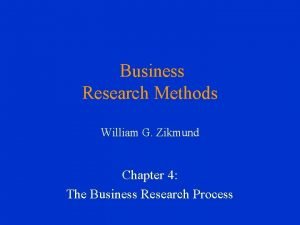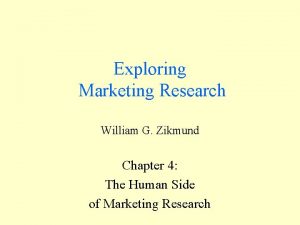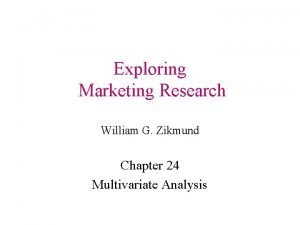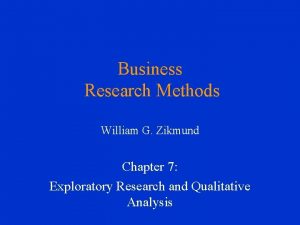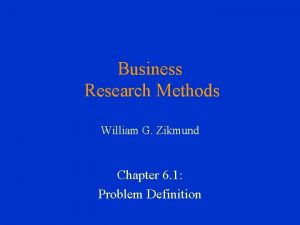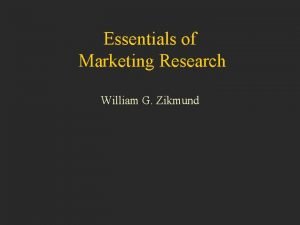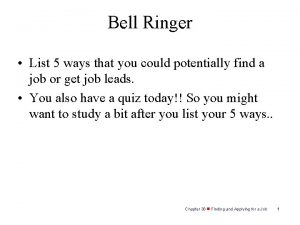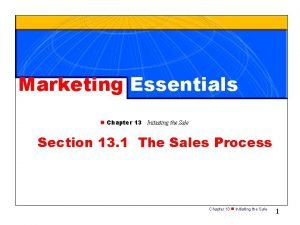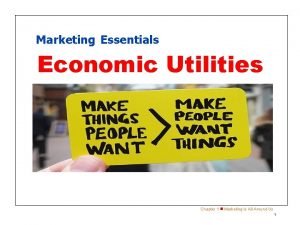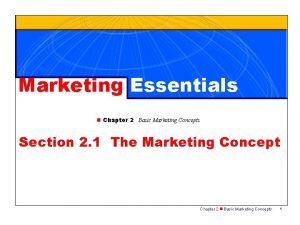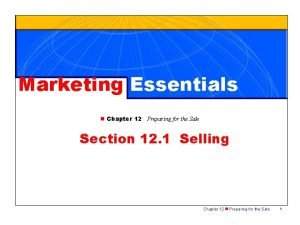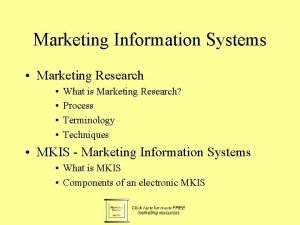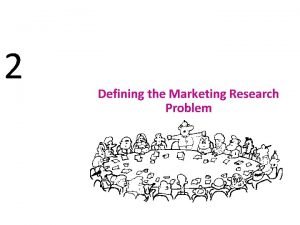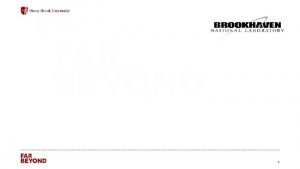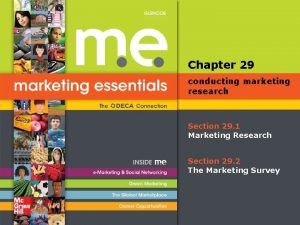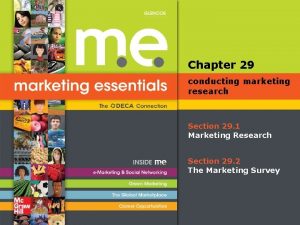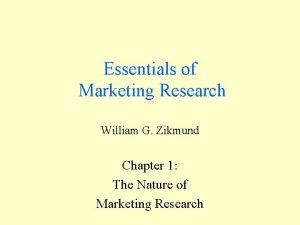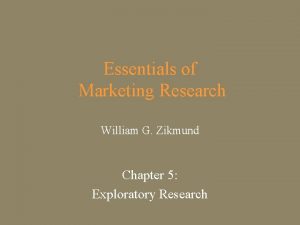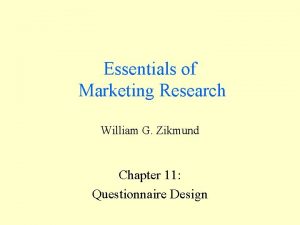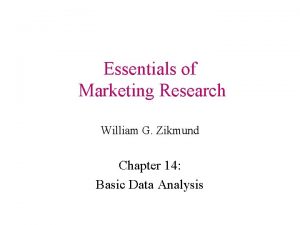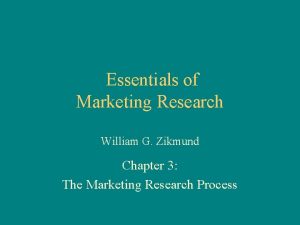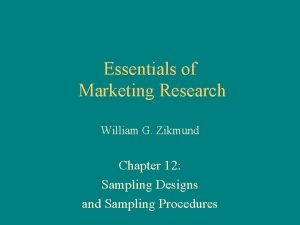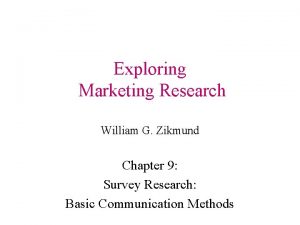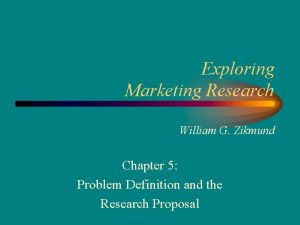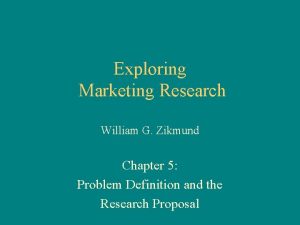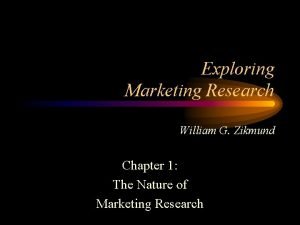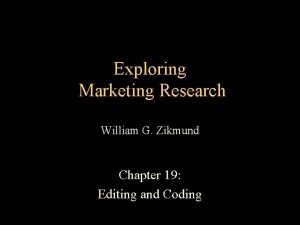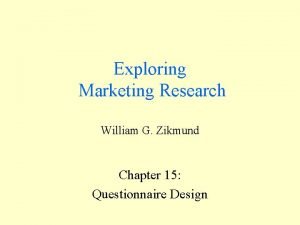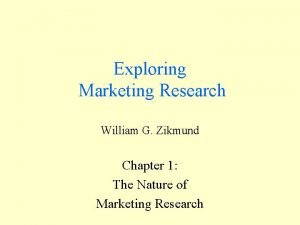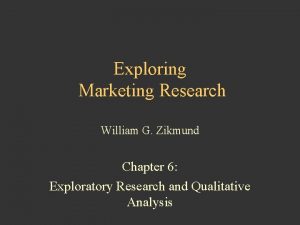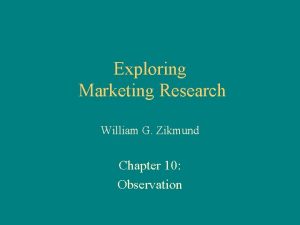Essentials of Marketing Research William G Zikmund Chapter





















































- Slides: 53

Essentials of Marketing Research William G. Zikmund Chapter 9: Experimental Research

Experiment • A research investigation in which conditions are controlled • One independent variable is manipulated (sometimes more than one) • Its effect on a dependent variable is measured • To test a hypothesis

Basic Issues of Experimental Design • Manipulation of the Independent Variable • Selection of Dependent Variable • Assignment of Subjects (or other Test Units) • Control Over Extraneous Variables

The experimenter has some degree of control over the independent variable. The variable is independent because its value can be manipulated by the experimenter to whatever he or she wishes it to be.

Experiment Treatment Alternative manipulations of the independent variable being investigated

Independent Variable • The experimenter controls independent variable. • The variable’s value can be manipulated by the experimenters to whatever they wish it to be.

Manipulation of Independent Variable • • Classificatory vs. continuous variables Experimental and control groups Treatment levels More than one independent variable

Experimental Treatments • The alternative manipulations of the independent variable being investigated

Dependent Variable • Its value is expected to be dependent on the experimenter’s manipulation • Criterion or standard by which the results are judged

Dependent Variable • Selection – e. g. . . sales volume, awareness, recall, • Measurement

Test Units • Subjects or entities whose response to the experimental treatment are measured or observed.

Two Types of Experimental Error • Constant errors • Random errors

Field versus Laboratory Experiments

Controlling Extraneous Variables • • • Elimination of extraneous variables Constancy of conditions Order of presentation Blinding Random assignment

How May an Experimenter control for Extraneous Variation? • • Eliminate Extraneous Variables Hold Conditions Constant Randomization Matching Subjects

Establishing Control

Demand Characteristics • Experimental procedures that intentionally hint to subjects something about the experimenter’s hypothesis

Demand Characteristics • Guinea pig effect • Hawthorne effect

Field vs. Laboratory Experiment

Laboratory Experiment Field Experiment Artificial-Low Realism Natural-High Realism Few Extraneous Variables Many Extraneous Variables High control Low Cost High Cost Short Duration Long Duration Subjects Aware of Participation Subjects Unaware of Participation

Control Groups Isolate extraneous variation

When does an Experiment have Internal Validity? Internal Validity - The ability of an experiment to answer the question whether the experimental treatment was the sole cause of changes in a dependent variable Did the manipulation do what it was supposed to do?

Factors Influencing Internal Validity • • • History Maturation Testing Instrumentation Selection Mortality

Isolating Extraneous Variation with a Control Group • History Effects • Maturation Effects • Mortality Effects

Type of Extraneous Variable Example History - Specific events in the environment between the Before and After measurement that are beyond the experimenter’s control A major employer closes its plant in test market area Maturation - Subjects change during the course of the experiment Subjects become tired Testing - The Before measure alerts or sensitizes subject to nature of experiment or second measure. Questionnaire about the traditional role of women triggers enhanced awareness of women in an experiment.

Instrument - Changes in instrument result in response bias New questions about women are interpreted differently from earlier questions. Selection - Sample selection error because of differential selection comparison groups Control group and experimental group is self-selected group based on preference for soft drinks Mortality - Sample attrition; some subjects withdraw from experiment Subjects in one group of a hair dying study marry rich widows and move to Florida

How can Internal Validity Increase?

Increasing Internal Validity • Control group • Random assignment • Pretesting and posttesting • Posttest only

What are the Different Basic Experimental Designs?

Quasi-Experimental Designs • One Shot Design (After Only) • One Group Pretest-Posttest • Static Group Design

One Shot Design (After Only) X O 1

One Group Pretest-Posttest O 1 X O 2

Static Group Design Experimental Group Control Group X O 1 O 2

Three Good Experimental Designs • Pretest - Posttest Control Group Design • Posttest Only Control Group • Solomon Four Group Design

Pretest-Posttest Control Group Design Experimental Group R O 1 X O 2 Control Group R O 3 X O 4

Posttest Only Control Group Experimental Group R Control Group R X O 1 O 2

One-Shot Design Internal Validity Problems • History – weak • Instrumentation – not relevant • Maturation • Selection – weak • Testing – not relevant • Mortality – weak

One-Group Pretest-Posttest Internal Validity Problems • History • Instrumentation – weak • Maturation • Selection – weak • Testing – weak – controlled • Mortality – controlled

Static-Group Design Internal Validity Problems • History – controlled • Maturation – possible source of concern • Testing – controlled • Instrumentation – controlled • Selection – weak • Mortality – weak

Pretest-Posttest Control Internal Validity Problems • History – controlled • Maturation – controlled • Testing – controlled • Instrumentation – controlled • Selection – controlled • Mortality – controlled

Solomon Four-Group Design Internal Validity Problems • History – controlled • Maturation – controlled • Testing – controlled • Instrumentation – controlled • Selection – controlled • Mortality – controlled

Posttest-Only Control Internal Validity Problems • History – controlled • Maturation – controlled • Testing – controlled • Instrumentation – controlled • Selection – controlled • Mortality – controlled

Solomon Four Group Design Experimental Group 1: Control Group 1: Experimental Group 2: Control Group 2: R O 1 X R O 3 R X O 2 O 4 O 5 O 6

Test Marketing • Test marketing is an experimental procedure that provides an opportunity to test a new product or a new marketing plan under realistic market conditions to measure sales or profit potential.

Selecting A Test Market • • Population size Demographic composition Lifestyle considerations Competitive situation Media Self-contained trading area Secrecy

Control Method Of Test Marketing • Small city • Low chance of being detected • Distribution is forced (guaranteed)

Advanced Experimental Designs Are More Complex • • Completely randomized Randomized block design Latin square Factorial

Complex Experimental Designs Control: no music Average minutes shopper spends in store 16 Experimental treatment: slow music 18 Experimental treatment: fast music 12

RANDOMIZED BLOCK DESIGN Blocking Variable Independent Variable

Factorial Design Independent Variable 2 Independent Variable 1 No Music No grocery cart signs Grocery cart signs Slow Music Fast Music

2 x 2 Factorial Design Ad A Ad B Men 65 Effects > Main of Gender Women 65 70 60 > Main Effects of Ad

Interaction Between Gender and Advertising Copy 100 90 Wo 80 me n Believability 70 Men 60 50 40 30 20 10 Ad A Ad B

Factorial Design -- Roller Skates Package Design Price Red Gold $25 $30 $35 Cell 1 Cell 2 Cell 3 Cell 4 Cell 5 Cell 6
 Business research methods william g. zikmund
Business research methods william g. zikmund Exploring marketing research
Exploring marketing research Exploring marketing research
Exploring marketing research William g. zikmund
William g. zikmund Business research methods by zikmund
Business research methods by zikmund Zikmund business research methods
Zikmund business research methods Zikmund scale
Zikmund scale Zikmund lucemburský
Zikmund lucemburský Marketing essentials chapter 38
Marketing essentials chapter 38 Merchandise approach method
Merchandise approach method Form utilities
Form utilities Essentials of social media marketing chapter 9 quiz
Essentials of social media marketing chapter 9 quiz Marketing essentials chapter 2
Marketing essentials chapter 2 William stallings network security essentials 5th edition
William stallings network security essentials 5th edition Kr
Kr Essentials of health care marketing
Essentials of health care marketing Marketing essentials meaning
Marketing essentials meaning Finer segmentation
Finer segmentation Marketing information systems and marketing research
Marketing information systems and marketing research Define marketing information management
Define marketing information management Marketing information systems and marketing research
Marketing information systems and marketing research Marketing information systems and marketing research
Marketing information systems and marketing research Marketing information systems and marketing research
Marketing information systems and marketing research Management decision problem definition
Management decision problem definition It essential chapter 8
It essential chapter 8 What are the ten essentials of a successful ffa chapter?
What are the ten essentials of a successful ffa chapter? It essentials chapter 9
It essentials chapter 9 It essentials chapter 14
It essentials chapter 14 It essentials chapter 12 quiz
It essentials chapter 12 quiz It essential chapter 11
It essential chapter 11 Business essentials 12th edition chapter 1
Business essentials 12th edition chapter 1 It essential chapter 5
It essential chapter 5 It essentials chapter 3
It essentials chapter 3 It essentials chapter 11
It essentials chapter 11 It essentials chapter 7
It essentials chapter 7 It essentials chapter 6
It essentials chapter 6 It essentials chapter 5
It essentials chapter 5 It essentials chapter 4
It essentials chapter 4 Math is the foundation of the kitchen and the back office
Math is the foundation of the kitchen and the back office It essentials chapter 2
It essentials chapter 2 It essential chapter 5
It essential chapter 5 Pata cable
Pata cable It essentials chapter 10
It essentials chapter 10 It essentials chapter 10
It essentials chapter 10 Ad altare dei answers chapter 1
Ad altare dei answers chapter 1 It essentials chapter 4
It essentials chapter 4 It essentials chapter 7
It essentials chapter 7 What are the ten essentials of a successful ffa chapter
What are the ten essentials of a successful ffa chapter It essentials chapter 8
It essentials chapter 8 It essentials chapter 6
It essentials chapter 6 Chapter 5 kitchen essentials 2
Chapter 5 kitchen essentials 2 It essentials chapter 13
It essentials chapter 13 Chapter 29 conducting marketing research
Chapter 29 conducting marketing research Chapter 29 conducting marketing research answers
Chapter 29 conducting marketing research answers
